Source: www.holy-transfiguration.org
On October 8th (September 25th, old style) the Church commemorates the great Russian wonderworker, Saint Sergius of Radonezh.
In 1314 the righteous noble couple, Cyril and Maria, who lived near Rostov the Great, gave birth to a son, Bartholomew. The infant refused his mother’s milk on Wednesdays and Fridays, and also on those days when Maria ate meat. At the age of seven Bartholomew was sent to school together with his brothers Stephen and Peter. Inspite of his diligence, learning came poorly to Bartholomew, and he tearfully prayed for the gift of “understanding book learning.”
One day Bartholomew saw a monk standing under an oak tree and praying. After finishing with his prayers, the elder gently asked the youth: “What do you want, child?” Bartholomew replied: “Pray to God for me and ask Him to open up my mind to book learning.” The elder prayed, then gave the youth a piece of prosfora and said: “Take this, child, and eat. It is given to you as a sign of God’s grace and for the sake of understanding the Holy Scriptures.” The monk then visited Bartholomew’s house, blessed his parents and commanded Bartholomew to read the Psalter. The boy began to fluently read the psalms.
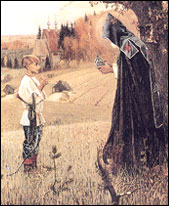 |
| Young Bartholomew meets a holy monk |
In 1328 Cyril and Maria moved to Radonezh. Bartholomew’s brothers chose married life, while he had the sole desire to leave the world and dedicate himself to God. Shortly before their death, the saint’s parents became monastics. Having become widowed, Stephen also entered the holy orders. After burying their parents, Bartholomew and Stephen went into a deep forest several miles away from Radonezh, where they built a monastic cell and a small church in honor of the Holy Trinity. Soon afterwards, unable to endure the difficulties of solitary dwelling, Stephen departed for Moscow and entered the monastery of Theophany.
On October 7, 1337 Bartholomew was ordained a monk with the name of Sergius. News of the new monk Sergius spread all over the environs and soon 12 brothers gathered around him. Several cells were built around the church and were surrounded by a high fence to protect them against wild animals. This was the beginning of the future Trinity-Sergius Lavra (1337). For a long time there was no abbot, nor priest. Due to his great humility, St. Sergius declined to be ordained a priest. He joined the others in building cells, baked bread, cooked the food, sewed clothes and shoes for the brothers, carried water. In 1354, after persistent pleas from the other monks, he became a priest and was given the rank of abbot. He served the Divine liturgy every day.
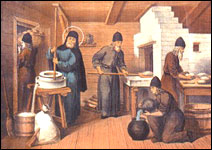 |
| St. Sergius’ labors with his monks |
The number of brothers increased. Many laymen began settling around the monastery, attracted by rumors of the abbot’s gift of miracle-working. By his prayers a spring of water welled up at the walls of the monastery, a dead youth was resurrected, a nobleman possessed by demons was made well. The Lord also glorified His righteous servant with the gift of clairvoyance.
Once St. Stephen, hierarch of Perm and a close friend of St. Sergius, traveled to Moscow. Passing close by to the monastery, he stopped, said a prayer and bowed down towards the monastery with the following words: “Peace be with you, spiritual brother.” At that time St. Sergius was eating with the brothers. Seeing his friend with his spiritual eyes, he, too, said a prayer, bowed in the direction of St. Stephen and replied: “May you also rejoice, shepherd of Christ’s flock, and may the peace of God be with you!” The brothers were quite amazed, but afterwards the saint explained to them the meaning of his words and named the place where St. Stephen had stopped.
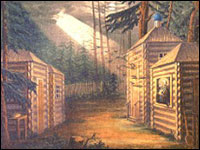 |
| St. Sergius’ vision of birds |
One night, while standing in prayer, the saint heard a voice calling him and saw a wondrous light shining from heaven and a multitude of beautiful birds. The mysterious voice said: “The Lord has accepted your prayer for your spiritual children. Thus will the number of your disciples multiply and will not become scarce even after you pass away; they will be adorned with great virtues if they follow in your steps.” This happened even during the saint’s lifetime. His disciples established numerous monasteries all over Russia.
St. Sergius’ monastery was a haven for wanderers, the poor and the sick, who received lodgings and food there. In the words of the first writer of the life of St. Sergius, “the hand of Sergius was stretched out to the needy like a great river.” His disciples saw an Angel concelebrating the liturgy with their abbot, they saw fire surrounding the altar and St. Sergius, and fire entering the Holy Chalice as the saint took communion.
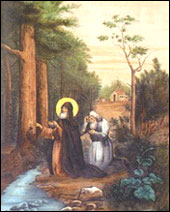 |
| St. Sergius miraculously calls |
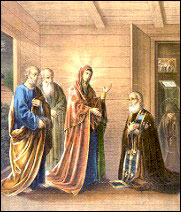 |
| The Holy Theotokos |
One night St. Sergius, together with his cell attendant, St. Micah, was honored by a visit from the Holy Mother of God, accompanied by the apostles Peter and John. The Holy Virgin said: “Fear not, My chosen one, I have come to visit you. Your prayer on behalf of your disciples has been heard; do not grieve also for your monastery: from now on it will have abundance in everything, not only during your lifetime, but even after your departure to the Heavenly Realm. I will never abandon this place and will always protect it.”
In 1380, while preparing for his campaign against Mamai, the holy Prince Dimitri Donskoy visited the monastery of the Life-giving Trinity and received St. Sergius’ advice and blessing.The saint said: “Go forth, my lord, fearlessly! The Lord will help you against the godless enemy. You shall conquer your enemies.” To aid the Prince in battle, St. Sergius also gave him two of his schema-monks - Alexander (Peresvet) and Andrei (Oslabya) - former warriors.
On September 8, 1380, on the day of the Nativity of the Holy Mother of God, the Russian army defeated the Tatars on the Kulikovo field, making the first step towards liberating Russia from the Tatar yoke. While the battle was in progress, St. Sergius gathered all his monks in the church and prayed to the Lord for success in battle, and afterwards offered thanks to God for the victory that had been granted.
St. Sergius was a great peacemaker among the warring Russian princes, convincing them with his meek and humble words to accept the sovereignty of the prince of Moscow.
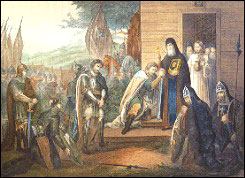 |
| St. Sergius blesses Prince Dimitri |
Six months before his death St. Sergius was granted a revelation of it. He gathered his monks around him, handed the administration of the monastery over to his disciple, St. Nikon, and gave himself over to solitude. Before his departure from this world, he once again gathered his monks and instructed them to remain in faith and unity, to preserve spiritual and physical purity, to have great love among themselves, to refrain from evil desires and passions, to keep moderation in food and drink, to espouse hospitality, to be humble and shun earthly glory and vanity. The saint then partook of the Holy Mysteries and quietly said: “Into Thine hands I give up my spirit, o Lord.” Immediately an indescribable fragrance issued from his body, while his face shone with heavenly rapture. This took place on September 25, 1392.
On July 5, 1422 the fragrant relics of the saint were uncovered and found to be incorruptible. They were placed in a new casket and set in the wooden church, from whence they were transferred to the Trinity Cathedral which was later built by St. Nikon, where they remain up to this day, giving comfort and healing to all who venerate them.
The Significance of Saint Sergius of Radonezh (1319-1392
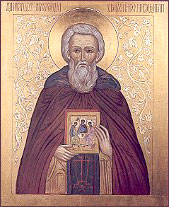 |
| Saint Sergius of Radonezh |
The name of Saint Sergius evokes not only an edifying and joy-inspiring page of Russia’s history, but is also a bright trait of the Russian people’s moral content,” – writes the famous historian Klyuchevsky. Saint Sergius of Radonezh – a spirit of simplicity and modesty, a quiet recluse, a modest abbot, a mentor and comforter. What manner of struggle sanctified his name to such a degree?
The Lord sent His chosen one at the difficult time not only of Russia’s outward enslavement, but also of its inner decline, profound despondency and spiritual collapse. The Venerable one was born under the Tatar yoke – a time when the nerves of all Russians still bore the painful impress of the horror caused by that national catastrophe, which resulted not only in material, but also in moral destruction, and for a long time subjected the populace to a stupefying torpor. To cast off the barbarian yoke once and for all, to establish a durable, independent state, and to induce non-Russians into the fold of the Christian Church, Russian society itself had to rise to the level of these great objectives, to uplift and strengthen its own moral powers, which had been abased by a century of bondage and despair.
It is to this moral instruction of the people that St. Sergius dedicated his life, to this end applying the means of a moral discipline accessible and comprehensible to all men – a living example, a visible embodiment of moral rule. He began with himself, and by a lengthy period of solitude, full of labors and privations, in the midst of a primeval forest, he prepared himself to become a guide for others.
The name of Sergius of Radonezh “transcends the boundaries of time,” writes Professor Klyuchevsky, because in its significance the task he undertook went far beyond the framework of his era, and by its beneficial activity profoundly impressed the life of succeeding generations. This task – the strengthening of the Russian state under a single authority at a time of fratricidal civil strife, oppression and subjection to the khans – was the fulfillment of the testament given to the hierarchy of the Russian Church by that saint of ancient Russia, the Metropolitan Peter, who had prophetically blessed the then small town of Moscow as the future ecclesiastical and governmental capital of the Russian land. St. Sergius was not a politician, just as he was not a “prince of the Church”; he was a teacher, an encourager, a peace-maker. At a difficult juncture in time, he blessed Prince Dimitri to wage a terrible war for Orthodox Russia, and gave him two schema-monks, Peresvet and Oslabya. The schemamonks, arrayed not in helmets and armor, but in their monastic garb replete with white crosses, gave the army of Prince Dimitri the appearance of a sacred crusade. During the battle, the Venerable one himself prayed in church, and “seeing’ the course of the battle, commemorated those who had fallen.
Worshipping the life-giving Trinity, the consubstantial and indivisible Trinity, Who is the beginning, source and well-spring of life, the Venerable one built a church to the All-holy Trinity. He saw it as a summons to unity for the Russian land, according to his biographer Epiphanius, “so that by gazing constantly upon it, we might conquer the fear created by the hated divisions of the world.” The extensive hospitality commanded by St. Sergius, gifts of all sorts, beginning with bread and ending with the healing of body and soul – all of this became a favorable condition for “gazing” at the church of the All-Holy Trinity and contemplating within it the prototype of Divine unity.
Thenceforth, the names of the Holy Trinity and St. Sergius became indivisibly linked in the Russian Orthodox conception. The Russian people did not forget the one who taught them to worship the Holy Trinity: soon after the saint’s death, a monastery dedicated to the Holy Trinity was built at the site of his birth (the Varnitsky Monastery near Rostov); its main church contained a side-chapel dedicated to St. Sergius. One may even say that it became a rule to build Holy Trinity churches with St. Sergius side-chapels.
The Lavra of the Holy Trinity, founded by the Venerable one, became the spiritual center, the heart, of Russian Orthodoxy. In 1892 Klyuchevsky wrote: “These monuments do not feed the people’s vanity, but rather the idea of descendants being responsible before their great ancestors, for the moral sense is a sense of duty. When we honor the memory of St. Sergius, we examine our-selves, we review our own moral stock which had been bequeathed to us by the great founders of our moral order, and we replenish it, filling up what had been expended. The gates of the Lavra of St. Sergius will be shut and the lamps which burn over his tomb will be extinguished only when we completely squander this stock without replenishing it.” And such a time did come! The Lavra was destroyed and was closed for many years when “Tatars and Mongols of our times” captured it. All its treasures were confiscated. The relics of the Venerable one were rummaged through (as were others all over Soviet Russia). Everything was mocked, defiled. Yet the lamps have been lit anew over the tomb of the Venerable one, and the Trinity-Saint Sergius Lavra now shines in golden splendor, reminding us of St. Sergius’ great, selfless, inspired service to the homeland, his spiritual stature and dedication to the Faith.
For future generations, St. Sergius became an eternal companion and guide. “He uttered few words, but gave the brethren a far greater example by his works,” – Epiphanius says of the saint. He left no writings behind him, but his spiritual contribution to the history of the Russian Church and to Russian culture is remarkably great. The disciples of the Venerable one received, in addition to the usual monastic pursuits, a blessing to undertake special ministries to the Church: the copying of manuscripts, iconography, church building. In an ancient account of the saint’s death, he is called “the initiator and teacher of all the monasteries in Russia.” And truly, no fewer than one fourth of Russia’s monasteries were founded by his closest disciples. St. Sergius, during his early wanderings, and countless future generations of his spiritual children after him, carried with them Russian enlightenment, Russian culture, the Russian ideal, and spiritual beauty.

